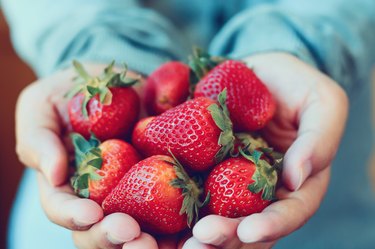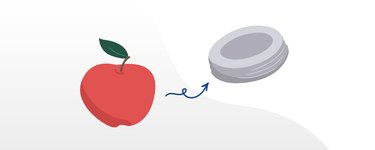
Whether it's fresh, frozen or dried, fruit is an essential part of our everyday diets. Indeed, eating the recommended amount of fruit each day helps fuel your body with the vitamins and nutrients it needs to stay healthy.
So, how much do you really need? According to the 2015-2020 Dietary Guidelines for Americans, which are compiled by the U.S. Department of Health and Human Services and the U.S. Department of Agriculture (USDA), adult men (ages 14 and older) should aim for 2 to 2 1/2 cups per day, while adult women should get between 1 1/2 and 2 cups.
But since fruits come in many different shapes and sizes — and, hey, it's not like you carry a measuring cup with you wherever you go — it can be hard to calculate just how much you're getting.
That's where our guide comes in. Here, you'll find everything you need to know about serving sizes of your favorite fruits, including handy comparisons to everyday objects that will help put portions in perspective.
Before you dig in, note that a serving in this case is equal to about a cup, and calorie counts are taken from the USDA's Food Composition Database.
Berries

Serving: 1 cup
About the size of... a tennis ball
Calories: These juicy little fruits are low in calories:
- Blueberries: 85
- Strawberries: 47
- Raspberries: 65
- Grapes: 61
Berries are big on flavor, but most of them (besides grapes) come in low on the glycemic index, a scale that ranks food (as low, moderate or high) when it comes to how likely it is to spike your blood sugar. Foods that are low on the index help keep blood sugar levels steady, which is beneficial for weight loss, according to Harvard Health Publishing.
This colorful fruit group is probably best known for being rich in antioxidants, or nutrients that can help protect our cells from damage, according to Harvard Health Publishing. Berries are also rich in flavonoids (plant chemicals), which may reduce cognitive decline in older adults, according to an April 2012 study published in Annals of Neurology.
Grapes, specifically, provide more than a quarter of your recommended daily intake of vitamin K, which supports bone health, according to the National Institutes of Health (NIH). Plus, a 1-cup serving of grapes (about 32 seedless) contains about 176 milligrams of potassium, which helps maintain or lower blood pressure, according to the Blood Pressure Association.
Avocado

Serving: One medium avocado
About the size of... a lightbulb
Calories: 322
A medium avocado provides about one cup of fruit, but the recommended portion size is about a third of that, per the USDA. A serving of avocado provides 3 grams of fiber, which, when paired with its high levels of polyunsaturated and monounsaturated fats, keeps you satiated, making this fruit a great weight-management tool, according to the Academy of Nutrition and Dietetics. While avocados are generally considered high in fat, the fats found in avocado are "healthy fats," and don't raise LDL (bad) cholesterol levels. Plus, while some fruits can be high in sugar and carbohydrates, a serving of avocado is low in both.
Banana

Serving: One large banana
About the size of... a dinner fork
Calories: 121
Bananas are popularly known for their high potassium levels, with one cup providing more than 10 percent of your daily recommended value, according to the National Institutes of Health. Potassium is an essential nutrient that can help decrease blood pressure and improve bone health.
Kiwi

Serving: Two kiwifruit
About the size of... two golf balls
Calories: 90
A cup of kiwifruit provides more than two and a half the daily minimum requirement of vitamin C, according to California Kiwifruit. A serving also packs 30 milligrams of magnesium, which helps with muscle and nerve function.
Apple

Serving: One small apple
About the size of... the diameter of a regular Mason jar lid
Calories: 74
An apple provides 3 grams of fiber toward your recommended daily target of 25 to 38 grams (for women and men, respectively), according to the Academy of Nutrition and Dietetics. While "an apple a day keeps the doctor away" is just a saying, this fruit has been linked with lowering the risk of chronic diseases like heart disease, according to a May 2015 study published in Nutrients.
Pear

Serving: One medium pear
About the size of... a computer mouse
Calories: 101
Pears have about 5.5 grams of fiber per serving, placing them among the highest-fiber fruit, according to the Mayo Clinic. The fiber, combined with the high amounts of fructose, can produce some laxative effects, according to a 2015 study published in Nutrition Today.
Orange and Grapefruit

Serving: 1 large orange; 1 medium grapefruit
About the size of... an 8-ounce coffee mug
Calories: 75 for orange; 65 for grapefruit
A single orange or grapefruit packs all the vitamin C you need in a day, according to the Mayo Clinic. This powerful antioxidant is great for boosting the immune system, according to the Academy of Nutrition and Dietetics.
Although oranges are sweet in taste, they are low on the glycemic index, mainly due to their fiber content and high polyphenol count. Polyphenols (antioxidants naturally found in plants) may help regulate blood sugar, according to a 2017 review published in the Medical Journal of the Islamic Republic of Iran.
Peach and Plum

Serving: One medium fruit
About the size of... a baseball
Calories: 68 per peach; 76 per plum
Like other fruit, peaches are high in antioxidants; however, peeling the peach actually decreases the antioxidant content, according to a November 2013 study published in Food Research International. Also opt for fresh peaches, as they contain higher levels of antioxidants than canned varieties, according to a September 2014 study published in the Journal of Clinical Biochemistry and Nutrition.
Although plums are high in sugar, they are also high in sorbitol, a sugar alcohol that helps promote healthy digestion, according to the USDA Foreign Agriculture Service.